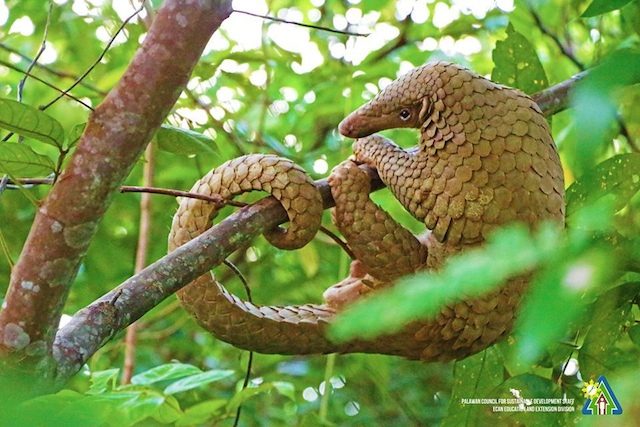SUMMARY
This is AI generated summarization, which may have errors. For context, always refer to the full article.

PUERTO PRINCESA, Philippines – The Palawan Council for Sustainable Development (PCSD) will conduct a study that will identify the population strongholds of the Palawan pangolin (Manis culionensis), in a bid to declare the areas as critical habitats of the critically endangered species.
Levita Lagrada, a zoologist with the PCSD Staff (PCSDS), said the establishment of critical habitats for pangolins would help the entire conservation community to focus protection efforts on these areas.
“We have to conduct studies to identify their population strongholds or the areas for protection,” she said in an interview Thursday, April 19.
The Palawan pangolin is one of 8 members of the pangolin family, which are indigenous to Africa and Asia. Also known as the Philippine pangolin, they have the smallest range of any pangolin species, only inhabiting the Palawan group of islands.
In Palawan, the PCSD, a multisectoral and interdisciplinary science body, is mandated to implement the Philippine Wildlife Act, which requires the establishment of critical habitats to ensure the sustainability of various threatened species.
“Once declared as critical habitats, there will be a management body that will oversee the execution of management plan over those areas,” Lagrada said.
Initially, she said the PCSD and USAID-funded Protect Wildlife project would undertake a study sometime this May or June to identify the population distribution of pangolins across the province.
“From its output, we could already tell where the priority areas for protection are,” Lagrada said.
She said protecting these areas would help spare them from illegal acts that drive habitat degradation and species loss.
“Those who will do the prohibited acts inside these critical habitats can be held liable,” Lagrada added.
Punishable human activities under the Philippine Wildlife Act involve destruction of critical habitats including illegal occupation, logging, forest conversion to agriculture, and mineral exploration and extraction.
The establishment of critical habitats is part of the 25-year strategy designed to safeguard the future of the species.
Working alongside with indigenous groups and key law enforcement agencies, experts from the Zoological Society of London (ZSL) Philippines, PCSD, International Conservation of Nature’s Species Survival Commission (IUCN SSC) Pangolin Specialist Group and Katala Foundation Incorporated designed the roadmap in a workshop held in Puerto Princesa City last week.
“The strategy we’ve come up with provides us with a roadmap to ensure the Palawan pangolin does not join the list of species to have disappeared from the planet,” ZSL Philippines Country Manager Godofredo Villapando said in a statement.
Poaching, population decline
The Palawan pangolin population is thought to have declined by more than 50% over the past 20 years, the conservation community said.
Like all pangolin species, Palawan pangolins are under threat from poaching for their scales and meat, which are trafficked to other parts of the Philippines and East Asia, and consumed locally as food or medicine.
Worldwide, more than one million pangolins are believed to have been snatched from the wild in the past decade alone.
These animals were recently up-listed to the highest category of protection under the Convention on International Trade in Endangered Species (CITES), making all commercial trade of wild-caught pangolins and their parts illegal.
Besides strengthening law enforcement to prevent poaching and trafficking, Lagrada said that part of the strategy is engagement with communities to increase local stewardship and protection efforts.
“We have to train the communities so they can help in wildlife law enforcement,” she added.
To ensure the ongoing survival of Palawan’s pangolin populations, Lagrada said the strategy also calls for public-private partnership. She said private entities can engage in conservation financing where investments are channeled to species conservation efforts. – Rappler.com
Add a comment
How does this make you feel?
There are no comments yet. Add your comment to start the conversation.